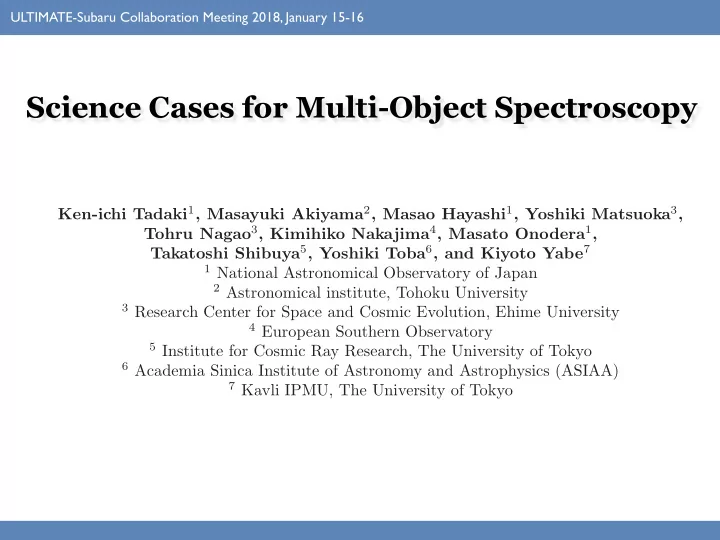

ULTIMATE-Subaru Collaboration Meeting 2018, January 15-16 Science Cases for Multi-Object Spectroscopy Ken-ichi Tadaki 1 , Masayuki Akiyama 2 , Masao Hayashi 1 , Yoshiki Matsuoka 3 , Tohru Nagao 3 , Kimihiko Nakajima 4 , Masato Onodera 1 , Takatoshi Shibuya 5 , Yoshiki Toba 6 , and Kiyoto Yabe 7 1 National Astronomical Observatory of Japan 2 Astronomical institute, Tohoku University 3 Research Center for Space and Cosmic Evolution, Ehime University 4 European Southern Observatory 5 Institute for Cosmic Ray Research, The University of Tokyo 6 Academia Sinica Institute of Astronomy and Astrophysics (ASIAA) 7 Kavli IPMU, The University of Tokyo
NIR MOS instruments on 8-10 m telescopes Keck/MOSFIRE Subaru/MOIRCS (Gemini/FLAMINGO-2) credit: Keck credit: Subaru credit: Gemini 3 ′× 6 ′ 4 ′× 7 ′ 2.0 ′× 5.8 ′ R~3600 R~3000 R~3200
Benefits from GLAO R~3000 instrument with a slit-width=0.4 ″ - point source: a factor of two improved - extended source (R e =2kpc): 60% improved MOSFIRE has R~3600 with 0.7 ″ slit
Synergy between ULTIMATE and PFS ULTIMATE-Subaru 2.5 H α wavelength [um] 2.0 [OIII] 1.5 [OII] 1.0 PFS Ly α 0.5 5.5 1.0 1.5 2.0 2.5 3.0 3.5 4.0 4.5 5.0 z sample1: z=2.0-3.7 emission-line galaxies with PFS spectra sample2: z=2.0-2.6 mass-complete sample with logM star >10.5 (sample2: z=2.0-3.7 emission-line galaxies identified by ULTIMATE- Subaru narrow-band imaging) In 65 nights, we get H,K-band spectra for 6000 galaxies over 1 deg 2 .
Star formation activity Mass-SFR relation (Kriek+15) Figure 14 . SFR vs. stellar mass for galaxies in the low (green) and middle redshift interval (red) for a Chabrier IMF. The 3 σ upper limits are indicated by the upside-down triangles. The yellow symbols indicate the galaxies that were serendipitously detected. The SFRs are derived from the combination of H α and H β . The 3 σ limits on the SFR, calculated using the optimal 3 σ line sensitivities in H and K, are shown for z ∼ 1.37 and z ∼ 2.09 (i.e., the lower boundaries of the redshift intervals), respectively. In this calculation we assume no dust attenuation. - study the main sequence of star-forming galaxies and the environmental dependence using the most reliable measurements of SFR
Star formation activity Mass-SFR relation (Koyama+13) - study the main sequence of star-forming galaxies and the environmental dependence using the most reliable measurements of SFR
Chemical evolution Mass-metallicity relation (Tremonti+04) Cluster galaxies are - more metal rich (Shimakawa+15) - as metal rich as field ones (Tran+15) - more metal poor (Valentino+15) - study the environmental dependence of mass- metallicity (or mass-SFR-metallicity) relation
Metallicity measurements with Te-method [OIII]4363 at z=1.7 (Yuan+09) OIII]1661,1666 at z=2.2 (Kojima+17) only ~10 galaxies at z~2 - significantly enlarge the sample size of z=2-3 galaxies with accurate metallicity measurements
ISM properties blue: z~1 green: z~2 red: z~3 - ionization parameter - shape of ionizing spectrum - electron density - abundances of heavy element
Low-mass strong emission line galaxies HSC ULTIMATE-Subaru - galaxies with excesses in broad-band photometries Low-z analogues of star-forming galaxies in very early Universe
Galactic outflows in galaxies at z=3-5 Sugawara+17 ULTIMATE: systematic velocity using nebular emission lines (e.g., [OII]) PFS: velocity shift using ISM absorption lines (e.g., MgII) - investigating the outflow velocity in galaxies at z>3
z z Cosmological Evolution of AGN number density Compton-thin AGNs Compton-thick AGNs Ueda+14 X-ray surveys Near-infrared surveys - investigating the cosmological evolution of number density of AGNs
HSC spectroscopy Low-mass galaxies High-mass galaxies Imaging (target selection) Ultimate-Subaru Ultimate-Subaru Optical spectroscopy PFS Near-infrared Summary A role of ULTIMATE-Subaru/MOS survey PFS
Recommend
More recommend